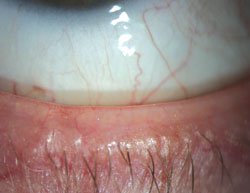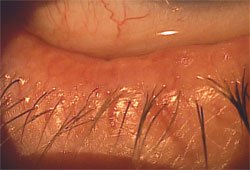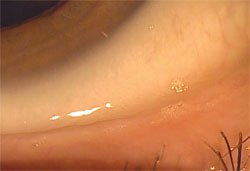Report elucidates meibomian gland dysfunction definition, diagnosis
An international workshop recommends an evidence-based approach to classifying and grading the disease and distinguishing it from dry eye syndrome.
A recently released report has defined meibomian gland dysfunction and recommends methods of diagnosis, treatment and clinical trial design.
 Kelly K. Nichols |
The Tear Film and Ocular Surface Society announced results of the International Workshop on Meibomian Gland Dysfunction. The report, which took more than 2 years to complete, incorporated evidence-based data gathered by more than 50 international researchers.
The report is a roadmap for clinical treatment and research for meibomian gland dysfunction (MGD), Kelly K. Nichols, OD, MPH, PhD, the corresponding author, said in an interview with Primary Care Optometry News sister publication Ocular Surgery News.
“It was more of a process rather than a single meeting that occurred,” Dr. Nichols said. “The report provides a blueprint for what should happen to move the field forward in the future.”
 Penny A. Asbell |
Penny A. Asbell, MD, FACS, MBA, OSN Contact Lenses Section Editor and chair of the workshop’s subcommittee on design and conduct of clinical trials, said there was a paucity of definitive information on the nature and specificity of MGD, less than the evidence on other types of ocular surface disease such as dry eye.
“If you look at the clinical trial data to date, it often is not clear if the trial is evaluating lid disease alone or lid disease in conjunction with dry eye disease,” Dr. Asbell said. “The whole conundrum of understanding these conditions and their interaction needs to be further explored.”
The report was published in a special issue of Investigative Ophthalmology & Visual Science.
Definition, classification
Dr. Nichols and fellow committee members defined MGD in the report.
“Meibomian gland dysfunction is a chronic, diffuse abnormality of the meibomian glands, commonly characterized by terminal duct obstruction and/or qualitative/quantitative changes in the glandular secretion. It may result in alteration of the tear film, symptoms of eye irritation, clinically apparent inflammation and ocular surface disease,” the authors wrote.
 MGD spurs changes in the tear film, symptoms of eye irritation and inflammation, and dry eye. Image: Nichols KK |
The group classified MGD into two major types based on meibomian secretion: low-delivery states, considered to be the most common cause of MGD, and high-delivery states. MGD spurs changes in the tear film, symptoms of eye irritation and inflammation, and dry eye, the authors said.
“We previously did not have a definitive definition for meibomian gland dysfunction,” Dr. Nichols said. “There have been classification systems, and what we’ve presented here is a revised classification scheme.”
A standard definition is essential for epidemiologic investigation of disease etiology, clinical presentation and progression, Dr. Nichols said.
 A patient with rosacea and advanced MGD. |
 Frothy tears is an indication of MGD. Images: Karpecki PM |
“We found that across many different papers, both clinical and basic research, there was a lack of terminology that was consistent,” she said. “It is difficult moving a field forward because if you’re not speaking with the same words, using the same language, you don’t know if you’re comparing apples to oranges or apples to apples. The report sets the appropriate framework.”
Diagnosis, treatment
The workshop devised a diagnosis and treatment algorithm that combines management of MGD and dry eye.
“There previously has not been an algorithm in existence for MGD,” Dr. Nichols said. “This is a new addition to the literature and very approachable from a clinical utility standpoint for clinicians in terms of trying to manage MGD in the context of dry eye disease, because we felt that it was very difficult to separate out dry eye from MGD and try to treat them as two distinct conditions.”
The workshop recommended a two-tiered approach to the diagnosis of MGD-related dry eye. First, normal subjects should be distinguished from those with dry eye of any type. Second, a differential diagnosis of MGD-related evaporative dry eye and aqueous-deficient dry eye should be performed, the authors said.
“Some of the dry eye prevalence studies that have identified patients with dry eye using symptoms very likely include a large percentage of patients who have meibomian gland dysfunction,” Dr. Nichols said. “We don’t really know, but the line is blurred between the two.”
The workshop also devised a disease staging system that ranks MGD grades and symptoms and factors in ocular comorbidities that may require concurrent management.
Clinical trial design
New norms of clinical trial design are necessary to advance research and develop effective treatments for MGD, Dr. Asbell said.
The subcommittee on design and conduct of clinical trials reviewed 26 published papers identified as clinical trials on MGD. Many of these papers offered no clear definitions or distinctions between MGD and dry eye, Dr. Asbell said.
Clinical trial designs allow for the generation of progressively advanced levels of evidence, she said.
“Typically, the highest level of evidence is a randomized controlled trial where the participants are masked,” she said. “Below this highest level are other levels of evidence, such as cohort data, where findings on a group of people are reported. At the bottom of the evidence tree are case reports. However, case reports have an important role to alert us of areas that require more extensive research, but they rarely can supply definitive information on diagnosis or treatment.”
An appropriate starting point for MGD research would be an observational trial that examines signs and symptoms of MGD, comparing MGD subjects with age-matched controls. In addition, long-term surveillance would provide key information on the natural history of the disease, how it first presents and change in MGD over time.
“Improved minimally invasive objective metrics for diagnosis and measuring changes would be very helpful,” Dr. Asbell said. “This information would allow for better protocols for clinical trials to determine the efficacy of various treatments and advance our ability to diagnose and treat patients with MGD.”
A randomized, masked clinical trial is the best defense against bias and provides the best evidence for effective treatment, Dr. Asbell said. – by Matt Hasson and Courtney Preston
Reference:
- Nichols KK, Foulks GN, Bron AJ, et al. The International Workshop on Meibomian Gland Dysfunction: Executive Summary. Invest Ophthalmol Vis Sci. 2011;52(4):1922-1929.
- Penny A. Asbell, MD, FACS, MBA, can be reached at Mount Sinai School of Medicine, 1 Gustave L. Levy Place, Box 118, New York, NY 10029; (212) 241-7977; fax: (212) 289-5945; penny.asbell@mssm.edu.
- Kelly K. Nichols, OD, MPH, PhD, can be reached at Ohio State University College of Optometry, 338 W. 10th Ave., Columbus, OH 43210; (614) 688-5381; fax: (614) 688-4474; knichols@optometry.osu.edu.

